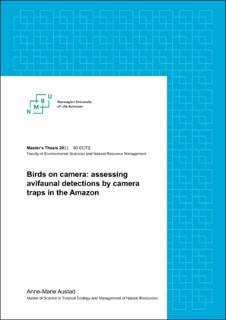| dc.description.abstract | Camera traps have become an increasingly useful tool for biodiversity surveys in tropical forests, but most of these studies focus on larger-bodied terrestrial vertebrates, particularly mammals. To date few camera trap surveys specifically target birds, yet studies on vertebrates represent a potentially valuable data source if incidentally recorded avifauna can be reliably identified from existing camera trap images. This thesis is one of the first studies to attempt identification of all avian species captured via camera traps, using ground-based arrays at three sites in the Brazilian Amazon. Data were used to analyse species richness, the functional traits of the detected avian species, and the activity patterns observed across the detected bird taxa. Sampling occurred in three protected areas: Terra do Meio Ecological Station, Juruena National Park, and Jamari National Forest. Camera trap surveys followed the Tropical Ecology Assessment and Monitoring (TEAM) network protocol for monitoring terrestrial vertebrates in tropical forests as part of the National Biodiversity Monitoring Program of Instituto Chico Mendes de Conservação da Biodiversidade (Programa Monitora ICMBio – Brazilian Ministry of the Environment). In total, 53,546 images with birds were captured, in which 66 species were identified, including the notable detections of two littleknown species Nothocrax urumutum and Neomorphus squamiger. Terrestrial avifauna were detected at a rate three times higher than species from higher forest strata, with the highest detection rates found in larger, ground-dwelling species. The observed activity patterns indicate a behavioural response to heat stress. Generally, terrestrial avifauna were most active in the cooler mornings and evenings, but certain families showed a less prominent bimodal diurnal activity. On the other hand, arboreal species were mostly detected towards noon, probably escaping to the shadier understorey during the hottest hours. Although this study demonstrates the high value of camera traps in surveying cryptic or elusive terrestrial avifauna, it also shows that smaller species are less likely to be detected, and higher forest strata species are only observed when these might come down to the forest floor. | en_US |

